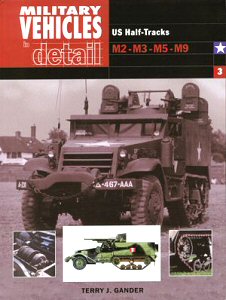

 Military
Vehicles in Detail 3
Military
Vehicles in Detail 3Review by Peter Brown
This account follows their development pre-war, then describes each series type by type. The Car, Half-Track M2 was designed for scout and towing roles while the Carrier, Personnel, Half-Track M3 with its longer body was configured for troop carrying, and these two were the main types in American service. Both came with either a front-mounted roller or winch and were produced with different armament styles, the -A1 versions having the distinctive "pulpit" for the fifty-calibre. Both also had mortar-carrying versions while the M3 was used as the basis for several self-propelled guns in 57mm, 75mm and 105mm calibres as well as the M13, M15 and M16 anti-aircraft vehicles.
Separate M5 and M9 series were produced for Lend-Lease, as well as using different engines and mechanical components they had flat-section mudguards and rounded rear hull corners. They were produced in fewer variations, the only ones being the M14 anti-aircraft vehicle. Some M3-series gun carrying types did go for Lend-Lease, though the T48 armed with the American 57mm anti-tank gun was intended for British use most ended up in Russian hands.
All the main series are covered, with many photos including record and in-service views. Coverage is mostly of the production variants, though some prototype and experimental vehicles are shown including four pages on designs carrying 40mm Bofors guns which never reached production. Post-war use and the conversions made after the war are not included.
Text describes development and production, with some good illustrations such as a chassis plan drawing, close-ups of the track units, tracks with snow chains, a basic M3-series chassis without hull, engines and the thirty and fifty calibre machine guns. Most in-action shots show American use with only a few British and one each Canadian and French subjects. Beware also of some photo captions which mix up the different types. Colour photos show several restored vehicles, and colour paintings show several colour schemes though units are not listed and one shows a T19 105mm HMC supposedly in British use based on markings in a well-known photo of an M3 75mm GMC shown on the next page. Plans in 1/35 of an M2A1, M3 75mm HMC and M16 MGMC are included, these are enlargements of plans in the big Hunnicutt book on the Haltracks.
Overall a good basic study, although there are a few mistakes for the newcomer to watch out for.
Page created 8 January 2005